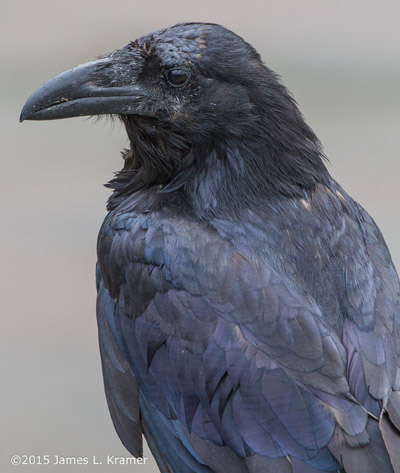 And so, we conclude our photo tour of Juneau Alaska, courtesy of Jim Kramer, unless he complains that I didn’t feature a particular image that he thought I should (you’ve seen fewer than half of what he sent me – I’m playing the editor game here.) It was a business trip with only three days of photo opportunities, so he accomplished a lot, despite the weather.
And so, we conclude our photo tour of Juneau Alaska, courtesy of Jim Kramer, unless he complains that I didn’t feature a particular image that he thought I should (you’ve seen fewer than half of what he sent me – I’m playing the editor game here.) It was a business trip with only three days of photo opportunities, so he accomplished a lot, despite the weather.
Seen here, a raven (Corvus corax) poses for a portrait. While their territory covers an awful lot of the North American continent, they aren’t to be found in Kansas, where Jim lives, or much at all in NC – I think I’ve seen them at a distance while at Pilot Mountain, but that’s it. They appear to be plentiful in Juneau, however, if the photos I received are any indication. These are pretty good light conditions to tackle subjects of this nature, by the way – the textures and subtle coloration of the feathers would likely have been lost in brighter, higher-contrast light, plus the associations we have with ravens tie in well with somber and moody conditions. A raven in a field of daisies just isn’t going to cut it.

In recognition of Jim’s flat Kansas residence, we shall gaze upon more of Alaska’s ridiculously implausible heights and mountains, such as this view from the Mount Roberts Nature Center looking across Gastineau Channel to Douglas Island and the town of Douglas, just across from Juneau, the barest hint of which appears at bottom. This is from an altitude of about 550 meters (1800 feet,) which is less than halfway up Mount Roberts itself.

I have no idea what peak this is – we shall call it “Squishy.” Don’t look at me that way, just because you’ve forgotten your classic literary references…
 It’s safe to say that if you prefer dry air, open fields, or lots of sunlight, Alaska is not for you. But that’s minimizing the dramatic and rare vistas, and even if you don’t want to live there, it can be a fascinating visit – I admit I’m envious. It’s the kind of remote and impressive landscape that you expect nature photographers to be inhabiting, instead of, you know, college towns in North Carolina…
It’s safe to say that if you prefer dry air, open fields, or lots of sunlight, Alaska is not for you. But that’s minimizing the dramatic and rare vistas, and even if you don’t want to live there, it can be a fascinating visit – I admit I’m envious. It’s the kind of remote and impressive landscape that you expect nature photographers to be inhabiting, instead of, you know, college towns in North Carolina…

Jim’s comment on the part one post now has me identifying this as Gold Creek in Cope Park, probably named appropriately because Juneau was primarily established by the gold rush – there aren’t too many other reasons to form a city in the margin between the channel and the steep mountains, way the hell away from everything else. If Jim found any gold there, he’s been keeping it mum – I’ll wait and see what kind of new photographic equipment he suddenly acquires…
 I am thinking this is looking northwest from Mount Roberts, and that splash of green is the marshy area of the northern part of the channel where the airport sits, but that’s the best I can do until Jim pipes up. I like the framing, especially with the trees reaching for the distant peak, and notice the depth provided by the layering blue haze.
I am thinking this is looking northwest from Mount Roberts, and that splash of green is the marshy area of the northern part of the channel where the airport sits, but that’s the best I can do until Jim pipes up. I like the framing, especially with the trees reaching for the distant peak, and notice the depth provided by the layering blue haze.

Yeah, I know, now we’re getting into the kind of stuff I normally show here. It’s not exactly intentional, it’s just that there are too few nice scenic landscapes to be found anywhere in this area at all, so I’m forced into doing semi-abstract little tableaux. Lucky for you that the traffic noise never comes through.
 This is Nugget Falls, which empties into Mendenhall Lake not too far from the base of the glacier. Probably not a place to go tubing, no matter how xtreemcooldood you are.
This is Nugget Falls, which empties into Mendenhall Lake not too far from the base of the glacier. Probably not a place to go tubing, no matter how xtreemcooldood you are.

Serious humidity. I doubt anyone there is going out each night to keep the plants watered…

Jim extended the camera up on a really long selfie-stick for this one… no, huh? All right, fine, it was from the plane on the trip back, as Jim says, about 40 minutes into the flight between Juneau and Seattle. Playing with the map, I have a faint suspicion that this is Mt Ratz, but it’s only a guess. Pretty dire-looking peak though, ain’t it?
And I close with a photo that appeals to the humor that both Jim and I possess – since we’re both atheists, a lot of people figure this is right up our alley anyway. The figurehead over the door is great, but don’t ask me why the windows are mismatched, or why the European spelling of “centre” is used. Just for class, is my guess…





















































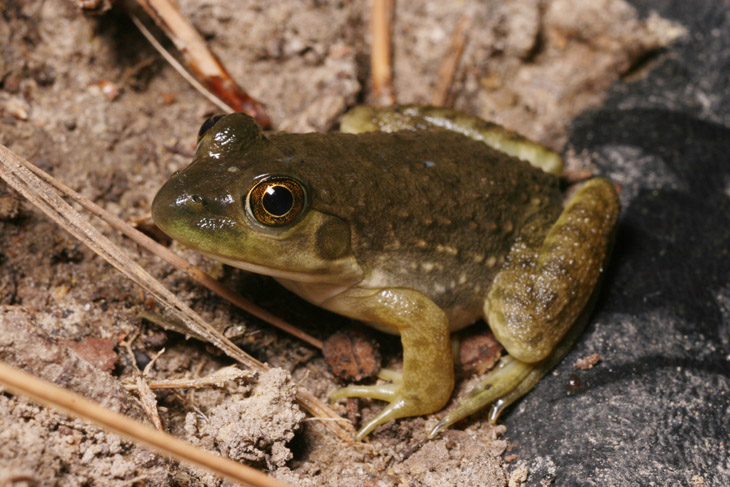
 I had actually planned to have a post regarding the summer solstice pop up Sunday, nothing elaborate, but at least containing current photos, but then life happened in the form of emergency surgery. No, not for me, but for The Girlfriend’s Sprog who, in a fit of impetuous infection, callously threw away her plans to retain her appendix throughout her life. She’s fine, but we have confirmed that she doesn’t come out of anesthesia well.
I had actually planned to have a post regarding the summer solstice pop up Sunday, nothing elaborate, but at least containing current photos, but then life happened in the form of emergency surgery. No, not for me, but for The Girlfriend’s Sprog who, in a fit of impetuous infection, callously threw away her plans to retain her appendix throughout her life. She’s fine, but we have confirmed that she doesn’t come out of anesthesia well.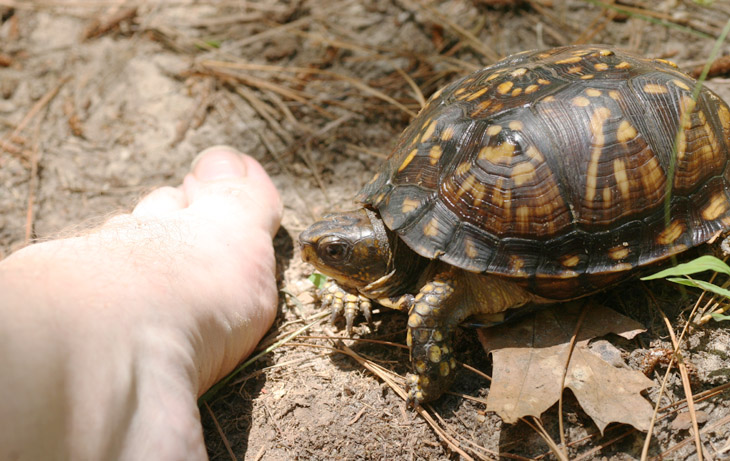
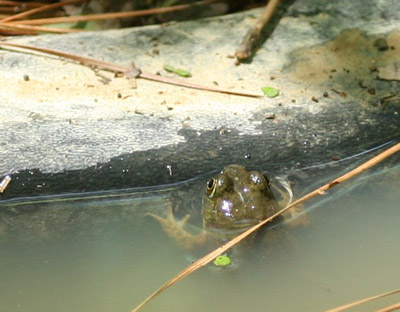 While retrieving her, I also spotted a frog submerging in the pond, and sat down after the turtle portraits to wait out the frog’s re-emergence. It did so only briefly, and not in a position where I could identify the species accurately, so this will remain a project for later. The pine straw seen here is ubiquitous in the yard, requiring daily removal from the pond, while the discoloration of the water is courtesy of the rains from a few days ago carrying in silt from the red clay – it will take days to settle out, and is one of the reasons why snorkeling in North Carolina is well-nigh pointless. Soon after this image was taken, The Girlfriend’s Younger Sprog said that she thought she should see a doctor, which sparked a 26-hour adventure. We’re going to ignore her next time she says that…
While retrieving her, I also spotted a frog submerging in the pond, and sat down after the turtle portraits to wait out the frog’s re-emergence. It did so only briefly, and not in a position where I could identify the species accurately, so this will remain a project for later. The pine straw seen here is ubiquitous in the yard, requiring daily removal from the pond, while the discoloration of the water is courtesy of the rains from a few days ago carrying in silt from the red clay – it will take days to settle out, and is one of the reasons why snorkeling in North Carolina is well-nigh pointless. Soon after this image was taken, The Girlfriend’s Younger Sprog said that she thought she should see a doctor, which sparked a 26-hour adventure. We’re going to ignore her next time she says that…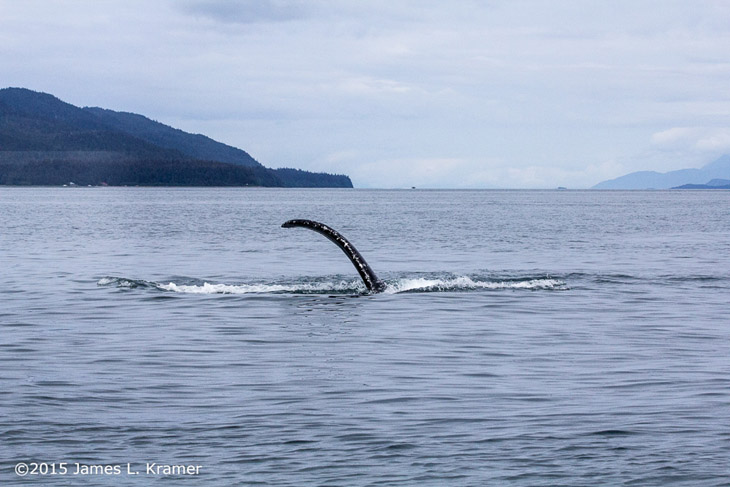


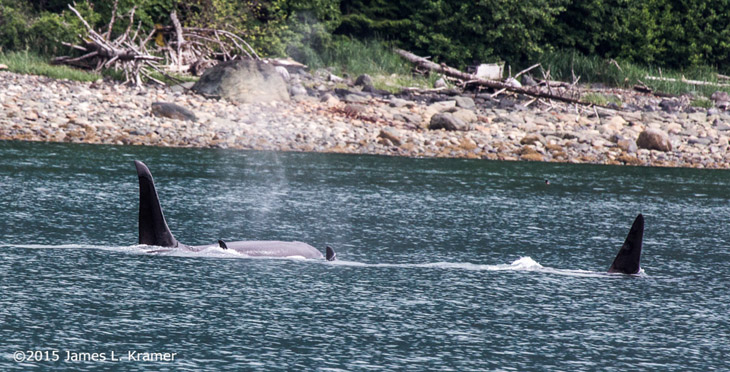
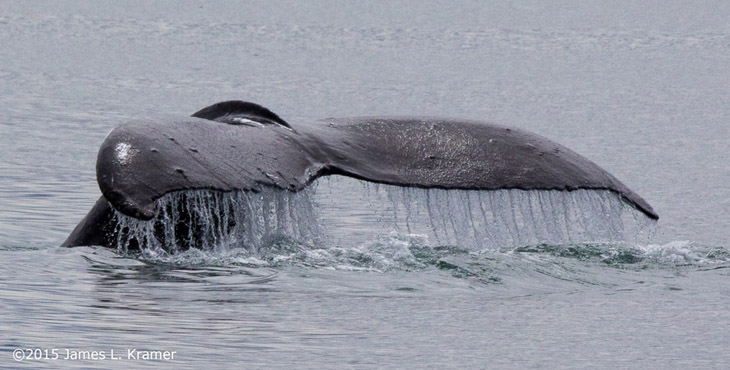



 Since it is now ‘officially’ summer, we will perversely jump back to almost the only color to be found in wintertime, holly berries in full fruit against the brilliant green of the leaves and a rich blue sky. I will admit to being quite pleased that we can find skies like this throughout North Carolina winters; having grown up in central New York, the winters there spelled overcast conditions for the majority of the time, which could be very depressing. The few occasions when skies like this appeared, it often spelled a wicked cold front coming through and, instead of being pleasant, it was bitterly cold and windy. The decision to get the fuck out of the state came on one such day, when our water pump had failed and I was in our shack of a wellhouse trying to get it operational again in wind chill conditions down below 0°f. It’s very easy to start asking questions like, “What am I doing here?” in circumstances like that.
Since it is now ‘officially’ summer, we will perversely jump back to almost the only color to be found in wintertime, holly berries in full fruit against the brilliant green of the leaves and a rich blue sky. I will admit to being quite pleased that we can find skies like this throughout North Carolina winters; having grown up in central New York, the winters there spelled overcast conditions for the majority of the time, which could be very depressing. The few occasions when skies like this appeared, it often spelled a wicked cold front coming through and, instead of being pleasant, it was bitterly cold and windy. The decision to get the fuck out of the state came on one such day, when our water pump had failed and I was in our shack of a wellhouse trying to get it operational again in wind chill conditions down below 0°f. It’s very easy to start asking questions like, “What am I doing here?” in circumstances like that.


 I used the word, “precipitous,” in the teaser, and anyone that knows me can tell you that I don’t use that word lightly. Juneau is an area of ridiculously vertical landscapes, as are quite a few portions of Alaska – not a place where Frisbees are popular, I’m betting. But you can probably hang-glide to Seattle…
I used the word, “precipitous,” in the teaser, and anyone that knows me can tell you that I don’t use that word lightly. Juneau is an area of ridiculously vertical landscapes, as are quite a few portions of Alaska – not a place where Frisbees are popular, I’m betting. But you can probably hang-glide to Seattle…





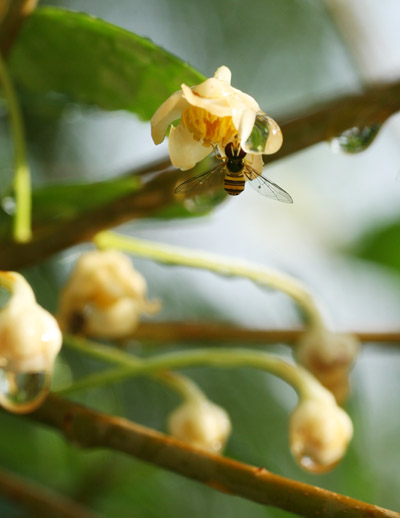 And then, the rains did come.
And then, the rains did come.
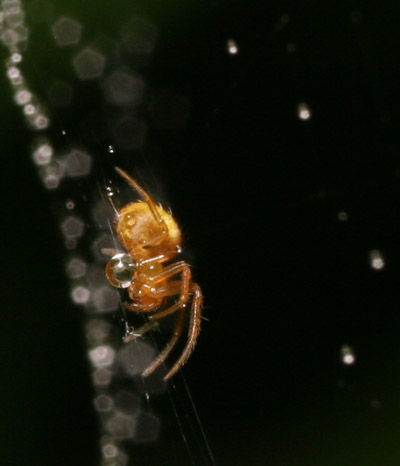 Spiders most often seek shelter, usually at one of the upper anchors of the web, but will resume position quickly, sometimes gathering drops that adhere to their bodies as they do so, though whether this is intentional to make it easy to drink, or incidental as they clamber past, is something I haven’t determined yet (and quite possibly won’t – who could tell if a spider is snagging dewdrops intentionally as it crawls across its web?) I have seen some spiders purposefully dislodging drops from the web, presumably to keep it invisible, while others seem to ignore it in the knowledge that it will evaporate quickly. Actually, there is probably no such knowledge – they just never evolved an instinct to worry about it because it never affected their survival. Let’s not credit too much cognition to the class.
Spiders most often seek shelter, usually at one of the upper anchors of the web, but will resume position quickly, sometimes gathering drops that adhere to their bodies as they do so, though whether this is intentional to make it easy to drink, or incidental as they clamber past, is something I haven’t determined yet (and quite possibly won’t – who could tell if a spider is snagging dewdrops intentionally as it crawls across its web?) I have seen some spiders purposefully dislodging drops from the web, presumably to keep it invisible, while others seem to ignore it in the knowledge that it will evaporate quickly. Actually, there is probably no such knowledge – they just never evolved an instinct to worry about it because it never affected their survival. Let’s not credit too much cognition to the class.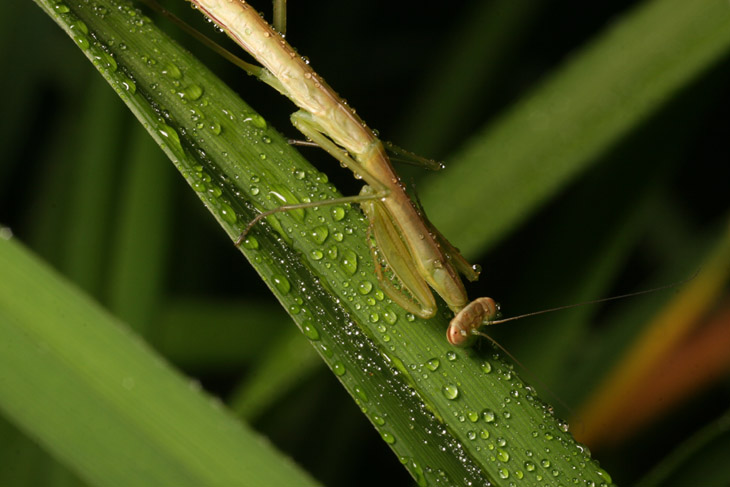
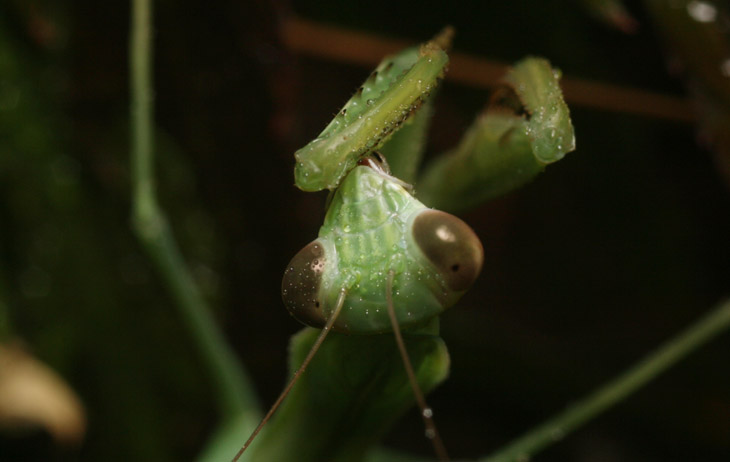
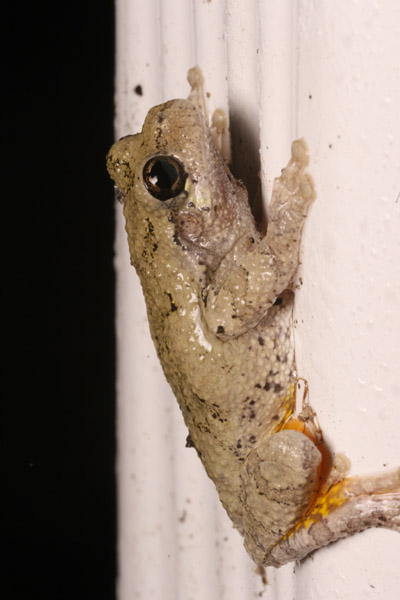 One little surprise appeared the other sweltering night, spotted on the downspout just after I misted the plants below, so I provided its own misting. This is likely a Copes grey treefrog (Hyla chrysoscelis) and they need the moisture, so it’s rare to see them out when it’s been so dry. Just to demonstrate my dudeness, not only did I provide a decent soaking, I turned on the deck light right overhead and left it on for a few hours in an attempt to provide more food for the little spud.
One little surprise appeared the other sweltering night, spotted on the downspout just after I misted the plants below, so I provided its own misting. This is likely a Copes grey treefrog (Hyla chrysoscelis) and they need the moisture, so it’s rare to see them out when it’s been so dry. Just to demonstrate my dudeness, not only did I provide a decent soaking, I turned on the deck light right overhead and left it on for a few hours in an attempt to provide more food for the little spud.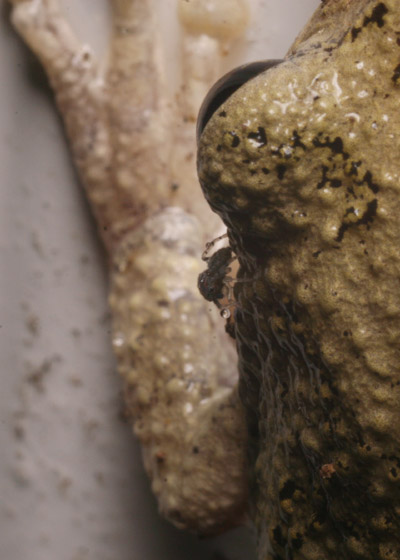 This little stowaway couldn’t be much larger than 1mm in body length, and by flashlight it remained hard to make out, though it could be seen perambulating around on Mt Frog here. If you look closely, you can see that it has its own supply of water, a tiny droplet adhering to its leg. But in a moment, it turned to face me, and the resulting tight crop confirmed what the other images had hinted at.
This little stowaway couldn’t be much larger than 1mm in body length, and by flashlight it remained hard to make out, though it could be seen perambulating around on Mt Frog here. If you look closely, you can see that it has its own supply of water, a tiny droplet adhering to its leg. But in a moment, it turned to face me, and the resulting tight crop confirmed what the other images had hinted at.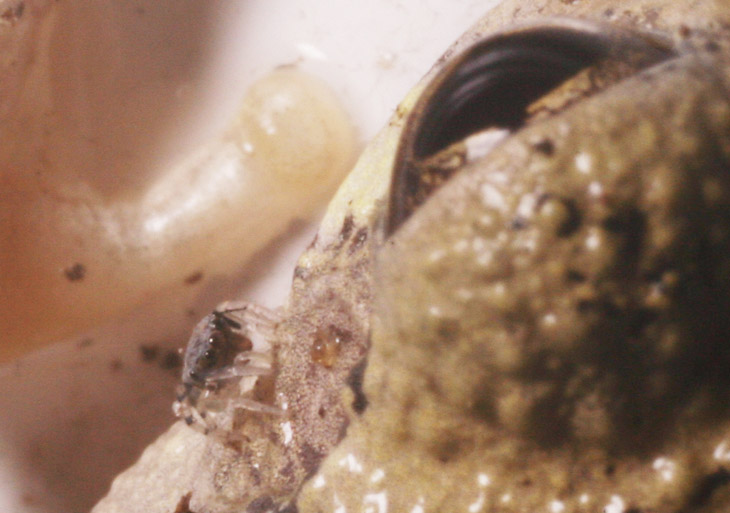
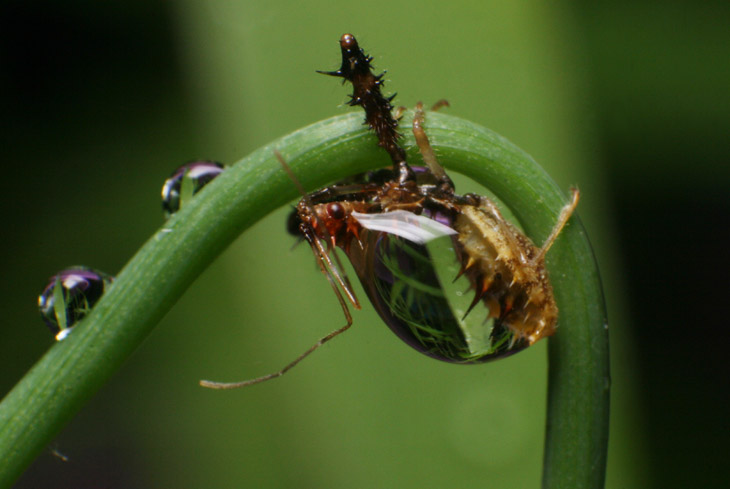
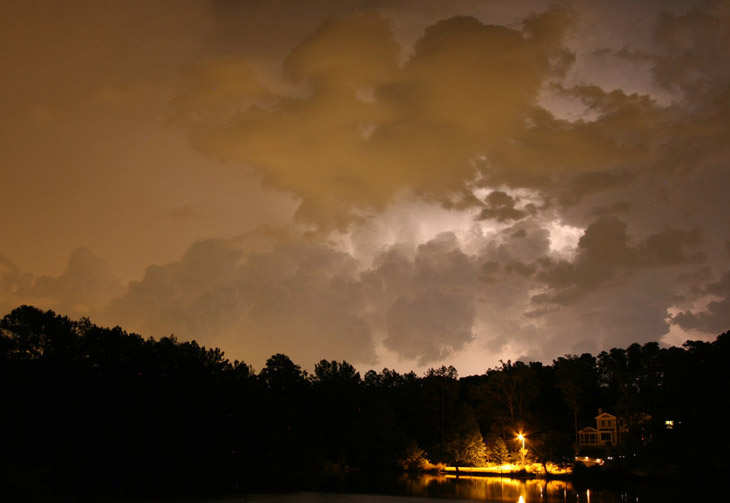
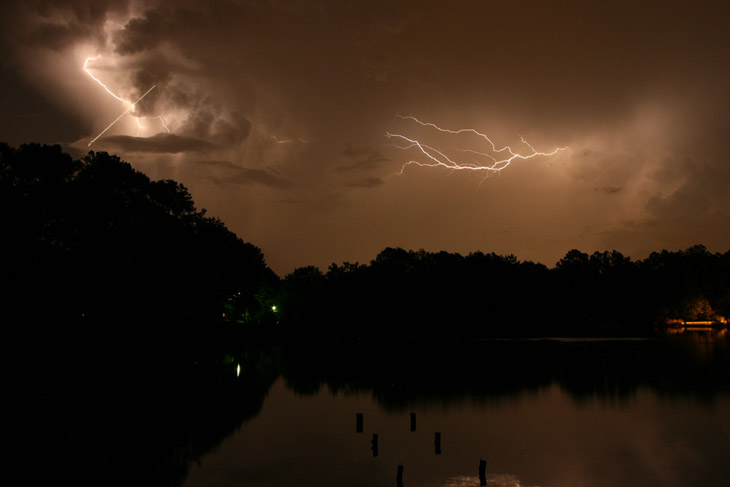
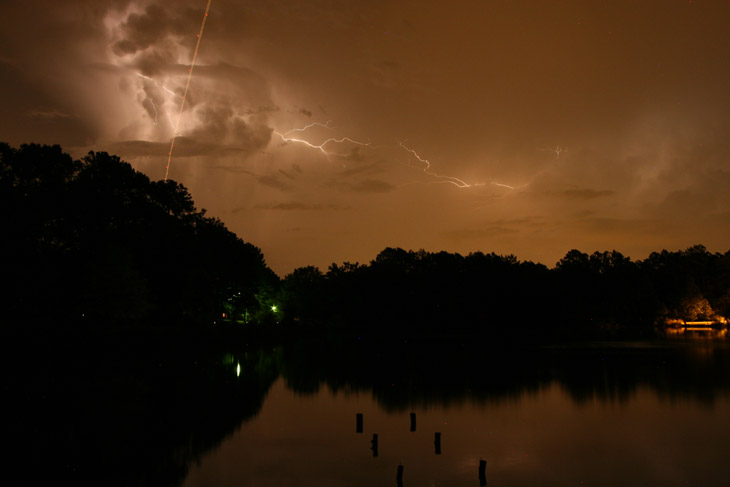

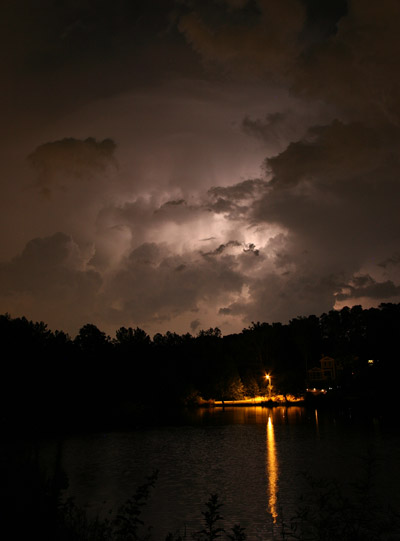 As the storm started to settle down a bit, I could start using the timing trick; lightning seems to follow a rough pattern, with a certain amount of time between strikes occurring from the same area of cloud. Count off the seconds between strikes, then lock the shutter open about ten seconds before that time is reached again. Like I said, its rough, and it’s entirely possible that it’s merely my own confirmation bias and the strikes are more random than that – I’d need to keep some pretty specific records to be sure either way. But this image here is a successful attempt, at least. I didn’t want the amber glow from the city lights in the clouds, so the only way to accomplish that is with a short exposure that captures a flash at just the right moment, and this one was a seven-second exposure timed for the reappearance of the flash. I’m pleased.
As the storm started to settle down a bit, I could start using the timing trick; lightning seems to follow a rough pattern, with a certain amount of time between strikes occurring from the same area of cloud. Count off the seconds between strikes, then lock the shutter open about ten seconds before that time is reached again. Like I said, its rough, and it’s entirely possible that it’s merely my own confirmation bias and the strikes are more random than that – I’d need to keep some pretty specific records to be sure either way. But this image here is a successful attempt, at least. I didn’t want the amber glow from the city lights in the clouds, so the only way to accomplish that is with a short exposure that captures a flash at just the right moment, and this one was a seven-second exposure timed for the reappearance of the flash. I’m pleased.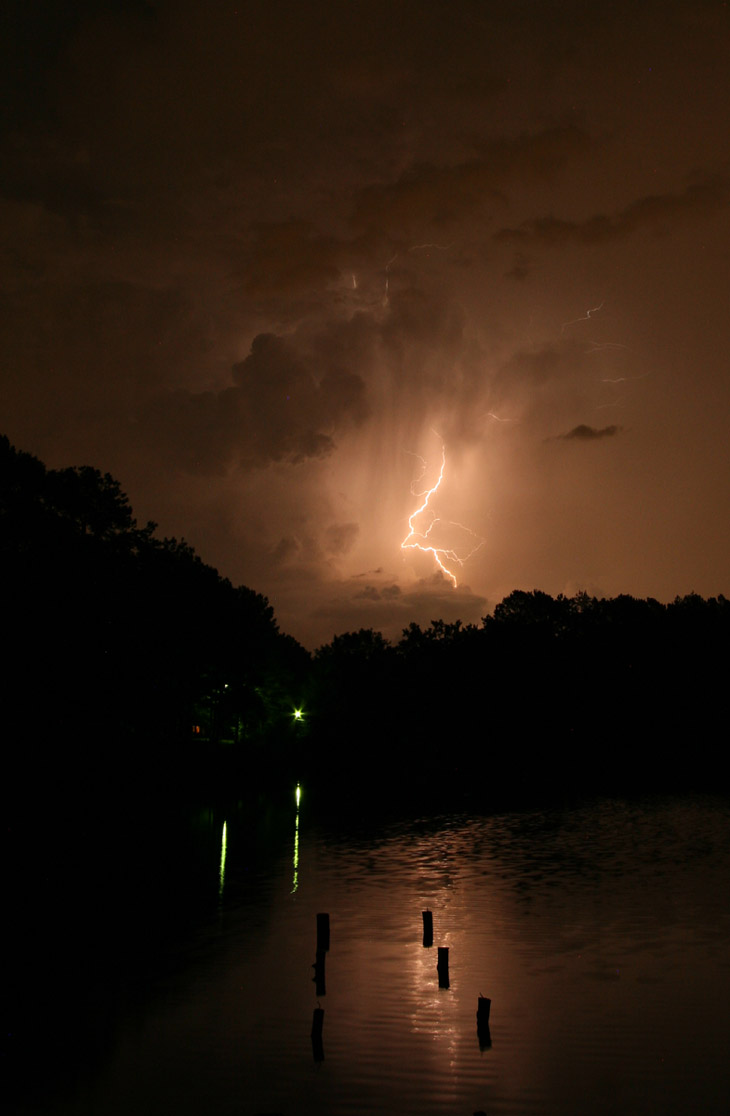
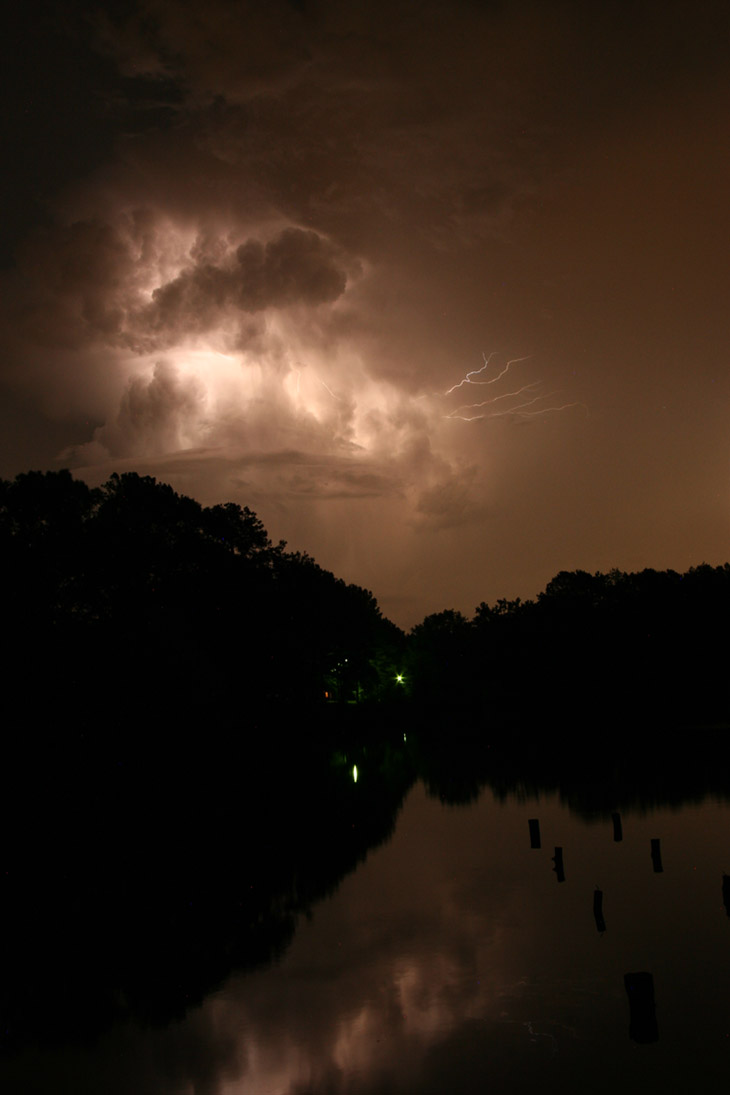
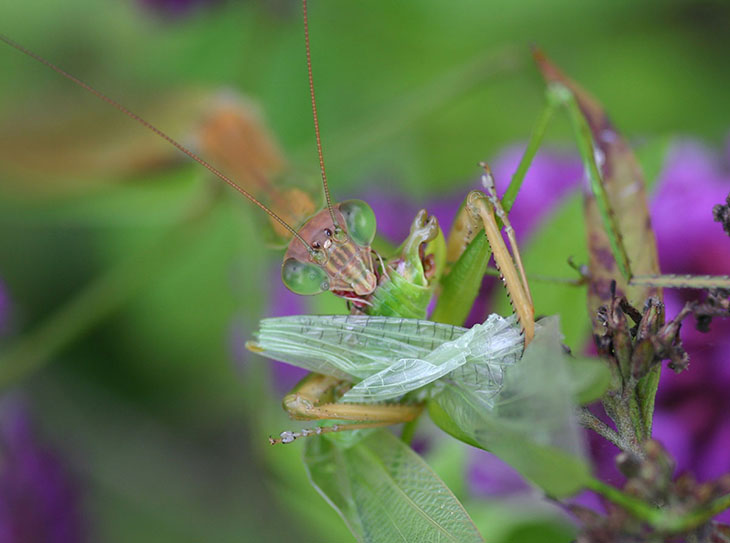

 This is just a tiny preview of posts yet to come – I think. I’ve learned not to bank on such things now, but we’re off to a good start, anyway. It’s likely to get a bit more precipitous around here.
This is just a tiny preview of posts yet to come – I think. I’ve learned not to bank on such things now, but we’re off to a good start, anyway. It’s likely to get a bit more precipitous around here.